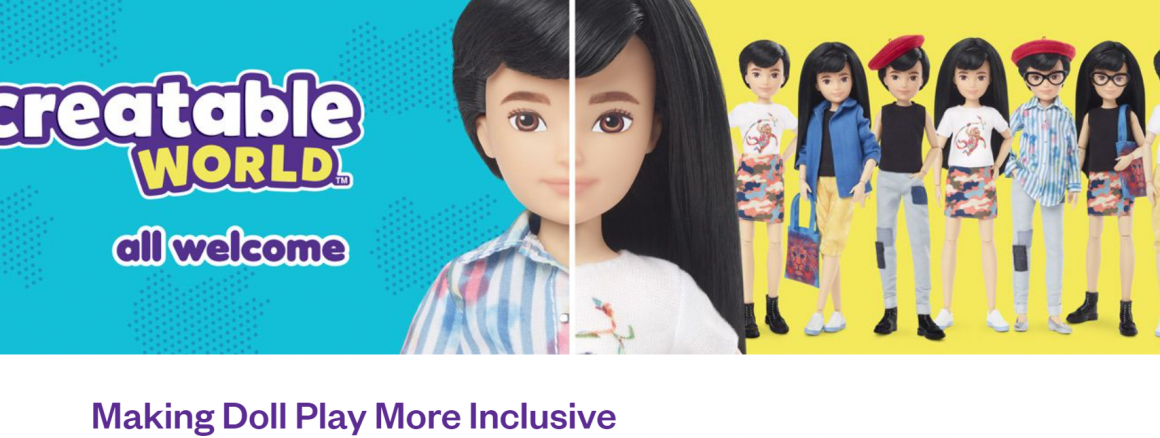MATTEL’S GENDER-NEUTRAL DOLLS CREATE STIR IN THE SERBIAN MEDIA
October 27, 2021
In late 2019, Mattel, a USA toy company, launched “world’s first gender-neutral doll”. Recently, the Creatable World doll became available in Serbia and some of the most influential media in the country reported on it. Some also created a platform to discuss the changes gender inclusive toys will bring to our society.
The Serbian media has a long history of allowing and even promoting hate speech against women and the LGBTQ+ community. However, in the past few years topics such as gender equality gained more coverage than ever before, especially this year when the Serbian government adopted the Law on Gender Equality. For the first time in the Serbian justice system sex is defined as “a biological characteristic on the basis of which people are divided into women and men,” and gender as “socially determined roles, behaviors, activities, and attributes that a particular society deems appropriate for women and men”.
Defining gender as a social construct created a lot of backfire from conservative groups and the national media took the role of a mediator between activists and politicians who were in support of or against the law. In practice, these debates usually involved an activist trying to explain the basics of gender equality and a right-wing politician that usually had statements full of hate speech and insults which journalists often report without critical approach. This picture is quite common in the Serbian media whenever human rights are being discussed. The same thing happened during the Belgrade Pride in September with the Law on Same-Sex Unions, currently being prepared by the Serbian government. It is also happening now with reporting on gender-neutral dolls. The media often fails to educate viewers on the topic they cover and allows hate speech mistakenly depicting it as “freedom of speech”.
During the past week, gender neutral dolls have gained considerable media attention. The gender-neutral doll does not have any specific sex characteristics and basically looks like a child, as opposed to grown-up looking dolls, made to fit societal standards of what a man and a woman should look like. Additionally, each Creatable World doll comes with clothes and wigs that are feminine, masculine and androgynous. With the slogan “a doll line designed to keep labels out and invite everyone in”it seems as the main idea behind the product is to make it inclusive for kids of all genders.
Kids are exposed to gender biases from the time they are born, weather it is through toys, clothes or different sports and activities they are encouraged to engage in. Little girls are given toys such as dolls, kitchen appliances, makeup and motivated to take up dancing or gymnastics classes whereas boys are supposed to like football, play with cars or construction sets. Famous toy manufacturer LEGO recently conducted a research that showed parents and children around the world still have stereotypical thinking on gender roles stating “that girls are typically encouraged into activities that are more cognitive, artistic and related to performance compared to boys who are more likely to be pushed into physical and STEM-like activities”. This research also shows that girls are less supportive of typical gender biases than boys and feel more free to engage in play and activities that are considered to be “meant for boys only”. Keeping in mind how harmful and limiting teaching gender roles to children is for everyone, LEGO committed to remove gender bias from its toys and many toy companies and parents are following.
On Serbian TV Prva this topic was covered in a program called “Same-sex dolls: imposing a trend or accepting diversity”. Even though the overall tone was not negative, throughout the show, the host and some of the guests kept calling the dolls “same-sex” and “sexless”, and neither the host Mira Lekić, nor the psycologist who was invited as expert on the topic made a clear distinction between sex and gender or between sexuality and gender identity. Lack of understanding of the difference between the two is the main trend in digital and print media as well.
It is important to acknowledge that this is one of the rare occasions that gender identity and educating children about it was even talked about in the media. Trans people are usually invisible in the Serbian media, and in rare cases when the media reports on trans stories it is usually through sensational headlines concerning celebrities, often reinforcing stereotypes and using transphobic language. It is seldom that the media reports on stories or problems of trans people in Serbia.
Even though most articles about the new gender-neutral dolls included trans voices and did not encourage transphobia, they were written in a disapproving manner and failed to educate citizens about gender identity and gender equality. The news website Kurir.rs published an article called “CAUTION: GENDER NEUTRAL TOYS CAN BE DANGEROUS TO CHILDREN! Psychologist: The market is forcing us to become HERMAPHRODITES!”. With this headline Kurir.rs is using sensationalism, creating panic based on unbacked claims and using transphobic language. Media reports on this topic are another reminder that education of journalists and media workers on how to report more inclusively is crucial for creating a media space with more diversity. As trans people are often victims of discrimination, violence and very harmful stereotypes, the media plays a very important role in shaping the opinions of their audience. In reporting trans stories ethically the Recommendations To The Media On Reporting On Trans People by organisation GAYTEN can be quite helpful.
Author: Anja Andjušić
Photo: MATTEL website
